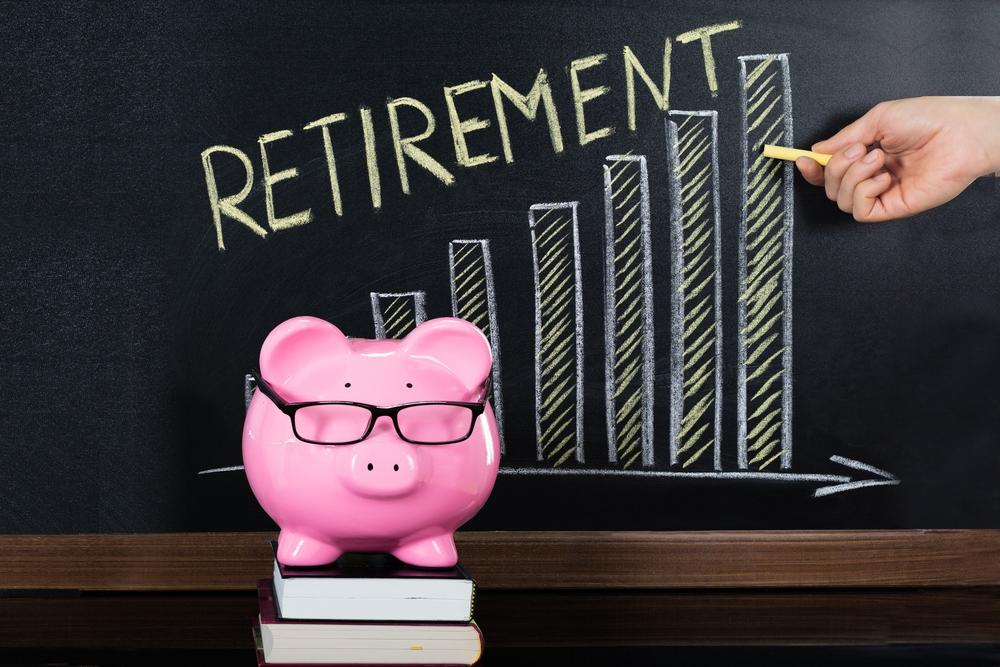
Money Milestones
A Crash Course in Starting and Growing Your Retirement Savings
Want to know why most younger adults don’t think much about saving for retirement? Probably because there’s a lot to think about. Furthermore, many mistakenly believe that they should wait until they’re making big bucks (whenever that will be) to begin setting money aside.
Admittedly, with so many different types of retirement accounts, IRS rules, and other options, oftentimes the benefits of these accounts get lost in the shuffle. Moreover, knowing where to start with all of it can be overwhelming. Don’t fret — I’m here to help.
The bottom line is that you should start saving for retirement as soon as you can. So, to help get you started, let’s take a look at why starting now is so important, what the big benefits of having a retirement account are, and a few tips for successfully growing your savings.
Creating a Retirement Saving Plan: Start Early, Start Small

When Should You Start Saving for Retirement? Why It’s Important to Begin Saving Early
The eternal irony is that, while young people are probably the least inclined to pay any mind to their eventual retirement, starting your savings as early as possible is key to having a prosperous retirement. Beyond the added principle you’ll build by contributing for longer, what’s really lucrative is the interest. In fact, the monetary differences between beginning your savings at age 25 and age 35 are simply staggering.
My go-to example of this comes from a report by JP Morgan Asset Management and published by Business Insider. This hypothetical first compares two different investors: one who contributed $5,000 a year for 40 years (age 25 to 65) and another who did the same but for 30 years (age 35 to 65). While the difference in their principal is only $50,000 at age 65, their total returns are far different. Assuming a 7% annual return, the 40 year saver would retire with $1,142,811 compared to just $540,741 for the 30 year saver. As you can see, that 10 year head-start led to a nest egg more than twice as large. Not bad, huh?
Stacking Pennies
If there’s one thing about that example I don’t like, it’s that, for many, setting aside $6,000 a year for retirement at age 25 is just not realistic. Don’t worry — you don’t need to contribute massive amounts of your income each year to maintain a retirement account. Furthermore, the majority of IRAs and Roth IRAs don’t have minimums, meaning you can start your account with just a few dollars.
Regardless of where you’re at, it can be very helpful to have a retirement savings plan. When my wife was first getting started with her Roth IRA, she told me she’d set aside $10 a week to contribute to her account. This meant she was putting $520 a year toward her retirement savings — a far cry from six grand but definitely not a bad start. Even today we keep that $10 a week tradition alive while also contributing to a 401(k) (more on that later) and occasionally making larger contributions when we can.
Be sure to check out the “Retirement Savings Tips” for more ideas on turning your small change into big dollars.
How Should You Prioritize Retirement Savings with Other Financial Goals?
While you can now see why it’s important to start preparing for retirement as early as possible and establishing a retirement savings plan, it’s impossible to ignore the fact that there may be other pressing financial obligations and goals you may have. Therefore, how can you find the right balance? Unfortunately, there’s no easy or one-size-fits-all answer to this question, but I do have an opinion.
Personally, in most situations, I think it makes sense to take advantage of any and all employer matching funds you can earn (we’ll talk more about these later). Then, depending on your level of debt and the interest rates on those debts, you may consider diverting more of your funds toward an IRA. Again, everyone’s situation will be different and, in some cases, it may come down to a matter of preference — but be sure to run the numbers and see what makes the most sense for your situation.
All About Retirement Accounts — The Pros and Cons
A Quick Round-Up of Retirement Account Types

Before we get into the pros and cons of retirement accounts, let’s briefly review some common account types. First up is the 401(k). A 401(k) is an employer-sponsored retirement plan allowing you to have contributions deducted directly from your paycheck. What’s more, oftentimes employers will match your contributions up to a certain limit. For the record, if you work for a nonprofit organization or the government, your employer may actually offer what’s called a 403(b). Despite the different names, these types of accounts are quite similar. Thus, in the interest of simplicity, I’ll just be referring to 401(k)s.
The other types of accounts we’ll be covering are IRAs — Individual Retirement Arrangements (or Accounts depending on who you ask). These come in two main flavors: Traditional or Roth. We’ll cover what the differences are in a moment but, for now, just know that IRAs can be opened directly by taxpayers instead of or in addition to employer-sponsored retirement plans. With that, let’s get into what makes 401(k)s and IRAs important tools for your retirement savings.
What’s Different About a Retirement Account?
At this point, you may be wondering what makes retirement accounts so special. After all, couldn’t you just set aside money for retirement in a normal savings account? Well, you could, but there are a number of reasons why that’s not the best financial idea.
Topping the list of why retirement accounts are better than savings accounts is the interest you earn. If you have a traditional savings account at one of the too-big-to-fail banks, chances are you only earn about .01%. Even over the course of 30 to 40 years, that’s still not going to amount to very much (not to mention that inflation is likely to well outpace this interest rate). Meanwhile, there are plenty of different retirement options that typically offer much better returns – 5-10%. To be fair, there is risk involved with many of these retirement options. That said, even safer options like money markets still often boast better returns than a regular savings account.
Another major benefit of retirement accounts is their tax-advantaged status. Depending on what type of account you choose, this could mean a couple of different things.
Biggest Retirement Account Benefits
Benefits of 401(k)s and IRAs
For regular IRAs and 401(k)s it means that your contributions aren’t taxed at the time you make them. So, if you make $30,000 for the year but contribute $6,000 to an IRA, your taxable income would be $24,000. Of course, when you do go to make withdrawals at retirement age, you’ll then have to pay tax on those pulls.
Benefits of Roth IRAs
For Roth IRAs, the situation is reversed. While you pay taxes on your income upfront, your withdrawals (and gains!) come tax free as long as you’re over a certain age. Even though this is often a better deal overall, some young savers without much to their names may balk at needing to pay taxes upfront.
Retirement Savings Contributions Credit (Saver’s Credit)
Incidentally, even Roth IRAs can help your current tax bill if you qualify for a Savers Credit — more formally known as a Retirement Savings Contributions Credit. Depending on how much you earn per year, you could qualify for a tax credit just by contributing to a retirement account. For example, in 2021, a married couple filing jointly that made less than $39,500 would be entitled to a credit equal to 50% of their contributions up to $4,000 (meaning a credit of up to $2,000). Sound too good to be true? You can check out the IRS page dedicated to this magical program for yourself.
Notable Retirement Account Drawbacks
Contribution limits
Due to all these benefits, there are limits and downsides to retirement accounts as well. First, IRAs and Roth IRAs put restraints on how much individuals can contribute to their accounts each year. For 2021, that limit is set at $6,000. 401(k)s also have maximum contributions, although the threshold is far higher (currently $19,500 for 2021).
Accessing your funds early (and why you shouldn’t)
Perhaps the biggest downside to retirement accounts is how inaccessible your money is. Well, it’s not exactly inaccessible per se but, once you put your money into an IRA or 401(k), it’s very expensive to get it back out. That’s because, with all the tax benefits the government is giving you to save, they really don’t want you tapping your account for anything other than its intended purpose. To dissuade you, withdrawals you make before you’re 59 and half are subject to a 10% penalty on top of any taxes you’ll need to pay on the funds. As someone who’s raided their 401(k) in the past, let me tell you it’s not worth it!
There are a few exceptions to this retirement account tax nightmare. For one, since taxes for Roth IRA contributions are paid upfront, you are technically able to make withdrawals from your principal (but not your gains) without penalty. And while you can’t take money out of your 401(k) permanently without charge, many accounts do allow you to take out a loan. These loans have their own set of pros and cons — e.g. low interest rate but lost gains — so be sure to carefully consider such an option.
In the end, the best practice is to just leave your retirement savings alone until, well, retirement.
Tips for Building Your Retirement Savings
Sign Up For Your Employer’s 401(k)
If you are eligible to sign up for a 401(k) at your job, do it! This is not only the hands down best way to get your retirement savings started but could also result in you getting some free money.

Let me explain: a 401(k) is a retirement account typically set up with your employer. What’s great about this is that you can decide on what percentage of your income you want to contribute and have the money automatically deducted from your paycheck. Better yet, a number of employers offer other perks such as matching funds and profit sharing.
For matching funds, typically your employer will contribute the same percentage of your income as you contribute up to a certain limit. Be aware that limit will vary greatly on the plan, but it’s not unheard of to get matching up to 4% in some cases. Additionally, some employers go one step further and gift their employees with profit sharing. Again, the amount of profit sharing you may get is dependent on a great many factors, but it is another way to build up your retirement nest egg.
So with all of those benefits be sure to check with your supervisor or human resources department to see if you are eligible to join your company’s 401(k) plan.
Try An App or Roboadvisor
As I mentioned, there’s no harm in starting small with your retirement savings and growing them over time. One potential way of doing this is to check out an app called Acorns. This app helps you set aside money without even really thinking about it. To achieve this, you first need to link your credit and/or debit card to Acorns. Doing so will then allow it to do what they call “Round Ups.” Whenever you make a purchase, Acorns will essentially round the price off to the nearest dollar and deposit the “loose change” into your account. So, for example, if you bought a cup of coffee for $4.35, Acorns would take an extra $.65 from your bank account and add it to your balance. From there, the app actually invests your money in a mix of stocks and bonds, which you can adjust to be more aggressive or conservative. You can read more about Acorns in this review.
If you are using Acorns, you could always choose to stick with their Lite plan and simply move the accrued funds over to your retirement account on a regular basis. However, the service also offers what it calls Acorns Later. With Acorns Later, you’ll be able to open an IRA and select from a variety of investment portfolio options. The only downside is that Acorns Later is currently bundled with their Invest and Spend platforms and comes at a cost of $3 per month (compared to $1 a month for the Lite plan with just the Invest platform). Because of this, while this may be an easy way to get started with investing and stick to your investment savings plan, you may want to consider other options if you’re sensitive to fees.
Another potential tool to help you save and invest for retirement is a roboadvisor. Platforms such as Betterment, Wealthfront, and others not only allow savers to set up automated transfers to retirement accounts but also manage their investments based on their risk tolerance and other factors. Like with Acorns, these tools can be a great help in building your retirement savings with minimal effort on your part. In terms of fees, instead of a flat dollar amount, most roboadvisors will instead charge management fees that amount to a percentage of your portfolio. Therefore, you may want to run the numbers and see whether a roboadvisor, Acorns, or another tool makes the most sense for you and your retirement plans.
Contribute your “found funds”

If you’re looking to kick-off your retirement savings or give it a boost, an unexpected windfall may just be the solution. Whether from a tax refund, stimulus check, gift, credit card cashback, or whatever else, putting these bonus funds to work can be far more beneficial than spending them on more stuff. Of course, being realistic, putting all of your found funds towards retirement isn’t much fun. Instead, I’d recommend holding onto a portion of your money for other purposes while putting the bulk in your retirement account. Then, you can think of any splurge you might make with the leftover money as a reward for setting up your future self.
Leave It In Peace
Just as I recommend contributing to your retirement account and not touching the funds, it’s also not always helpful to keep too close of an eye on your funds. If your 401(k) or IRA is invested, you will have up days, down days, up months, down months, etc. etc. etc. This can be exciting or depressing depending on the results, but you shouldn’t put too much stock (pardon the pun) into these short term changes. Remember: saving and investing for retirement is a long game. In many cases, the best plan of action is to stay the course and not panic. Case in point: investors who held on through the 2008 financial crisis came out on top when all was said and done. That said, you will want to get more conservative with your investments as you get closer to retirement, but that’s a conversation for another time.
Retirement Savings FAQ
How long will my retirement savings last?
Obviously the answer to “how long will my retirement savings last” will depend on a few factors. First, you’ll need to calculate how much money you anticipate having when you retire. Then, you’ll have to estimate how long you’ll live after retiring. Yes, this is a bit morbid, but could be useful if you’re concerned. If you are interested in getting a rough estimate of how much you’ll need to save for retirement, you can use a retirement calculator to help give you a better idea.
How do I start saving for retirement?
If your employer offers a 401(k), this is one of the best ways to start saving for retirement. However, if you don’t qualify for a 401(k) or similar 403(b), you might consider opening a traditional IRA or Roth IRA. In fact, depending on where you open your IRA, you may be able to deposit just a few dollars at a time, allowing you to slowly grow your savings until you’re able to contribute more.
What is the average retirement savings?
First, when looking at the average retirement savings, results are typically broken up by age since older adults have more time to save. Additionally, studies often feature both the average savings along with the median. With that in mind, according to NerdWallet, the average retirement savings among those under 35 is $30,170 while the median in this group is $13,000. This increases to an average of $131,950 and median of $60,000 among those aged 35 to 44 and continues to rise from there.
When should you start saving for retirement?
The simple answer is “as soon as possible.” Thanks to the power of compounding interest, starting early can help you build your retirement savings much more effectively. While this may be challenging, there are now plenty of options that can help you start small and make progress as your financial life evolves.
What is the best way to make retirement savings contributions?
Again, this will depend on your situation. However, for most employees, a 401(k) will be the best and easiest way to start saving for retirement. Meanwhile, those who aren’t eligible for a 401(k), want greater control over their investments, or want to save additional funds on top of their employer-sponsored plan may consider opening an IRA. With an IRA, you can often choose how much to contribute at a time, allowing you to customize your retirement saving plan to meet your needs and finances.
What is retirement savings contribution credit?
As we discussed, the Retirement Savings Contributions Credit (also known as the Saver’s Credit) is an IRS program that rewards lower-income adults for making retirement account contributions. There are four tiers of the saver’s credit based on your income level: 50% of your contributions, 20% of your contributions, 10% of your contributions, or 0%. The total value of this credit is capped at $1,000 for single filers and $2,000 for married couples filed jointly.
Between the different accounts, contribution limits, taxes, and more, there’s a lot of confusion that surrounds retirement savings. However, when you break things down, it’s really not all that complicated. In fact, you can start saving for retirement with just a few dollars and grow it into something much more sustainable by the time you retire. So what are you waiting for?
Leave a Reply
You must be logged in to post a comment.





I really like what you said about how saving as early as possible is key to having a prosperous retirement. My son is in his mid-20s, and I don’t think he has the foresight to start saving for his eventual retirement. He’s doing really well, and I’ve heard he has a significant promotion coming up. I’ll be sure to have a sit-down talk with him so he can consider planning for his future as early as now. Thanks!
Thanks for the kind words, Kit. When I was around that age, I made a point to put 10% of my pay in my 401(k) — but I cheated a bit and included matching funds in that. Better than nothing!
This is a really compelling article Kyle and you’ve definitely highlighted the fact that most of our younger generation are blindsighted by the importance of putting money away. Having their super set and almost ignorant about why it is in place is something that should be educated better. I will share this with my family!
Thanks for the kind words, Ross — and thanks for sharing!
Very good article on investing. Getting started when you’re young is most important. I give the advice my Grandma gave me. Keep your investment as safe as you can with CDs and she told me to buy Treasury bonds. I have done both. I know my money is as safe as could be.
It’s never too early to start your retirement savings regardless of what type of account.
Start early and start small. You’ll thank yourself in the future.
Its important to teach the younger generation the importance of saving for retirement.